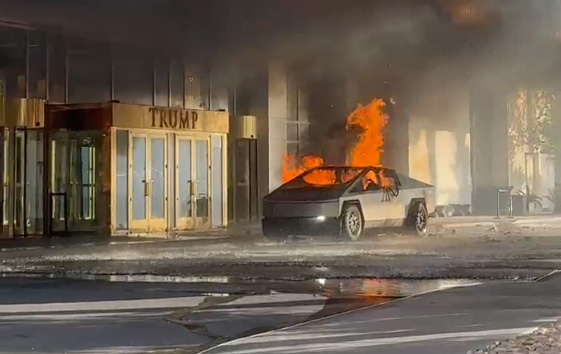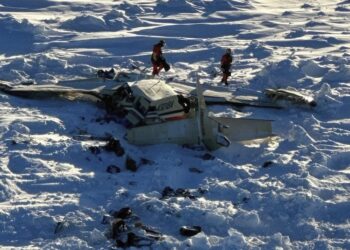(NewsNation) — FBI investigators cannot definitively link the deadly attack that occurred early New Year’s Day in New Orleans with the Tesla Cybertruck explosion in Las Vegas, but several similarities have been found between the two men involved, officials said Thursday.
A NewsNation source identified the driver of the Tesla truck that exploded outside the Trump International Hotel on Wednesday morning as Matthew Livelsberger, an active Army soldier from Colorado. The Clark County, Nevada, Coroner’s Office confirmed Livelsberger’s identity on Thursday afternoon following an autopsy.
But investigators said that tattoos found on the body matched those belonging to Livelsberger. A military identification card and passport belonging to Livelsberger were also found at the scene of the explosion, police said. Investigators believe that he was the only person to be inside the truck, which was rented in Colorado.
The FBI, meanwhile, identified the driver of a rented Ford truck that killed 14 people and injured at least 35 others in Bourbon Street as Shamsud-Din Jabbar, who also had a military background in the U.S. Army.
Here is what is known about the similarities between Livelsberger and Jabbar.
Liveslberger and Jabbar served in the United States Army
The Department of Defense confirmed that Livelsberger was a Special Operations sergeant with the Green Berets and that he spent much of his time in the Army at Fort Carson in Colorado and in Germany.
The Army told NewsNation that Livelsberger was assigned to the 10th Special Forces Group in Stuttgart, Germany. The spokesman also said that Livelsberger received several awards, including the Bronze Star Medal with Valor and other awards and commendations.

Livelsberger enlisted as an 18X and served in active duty from January 2006 to March 2011, a spokesman said. He then joined the National Guard from March 2011 through July 2012. After that, Livelsberger was in the Army Reserve until December 2012, when he entered active duty as an Army Special Operations soldier.
Las Vegas police said Thursday that Livelsberger served at Fort Bragg in North Carolina and Afghanistan in 2009.
Investigators said that like Livelsberger, Jabbar also served at Fort Bragg and in Afghanistan in 2009. However, it is not yet known whether the two men were part of the same unit or in the same region of Afghanistan during their deployment.
Investigators said Thursday they are working to confirm specific details about the two men’s military careers that could place them in the same unit at Fort Bragg.
Jabbar was part of the regular Army from March 2007 to January 2015 as a human resource specialist (42A) and information technology specialist (25B) before transitioning to the Army Reserve as an IT specialist from January 2015 to July 2020, an Army spokesperson told NewsNation.

He deployed to Afghanistan from February 2009 to January 2010 and held the rank of staff sergeant at the time of his discharge, according to the spokesperson.
Before serving in the Army, Jabbar enlisted in the Navy in August 2004 under a delayed entry program but was discharged a month later, a Navy official said.
Like Livelsberger, Jabbar was the recipient of several Army medals and commendations, including the Global War on Terrorism Medal and two Army Good Conduct medals.
Livelsberger and Jabbar rented vehicles from Turo
Investigators have confirmed that both the Ford truck used in the New Orleans attack and the Cybertruck that exploded in front of the Las Vegas hotel were rented through Turo, an online car rental app.
Las Vegas police said Thursday that Livelsberger picked up the truck in Denver on December 28. Investigators then used Tesla charging station data to track the vehicle’s movements. Police said that the truck was charged in Monument, Colorado, on Dec. 30 and then was charged in Colorado and New Mexico on New Year’s Eve.
On New Year’s Day, the truck was charged at three locations in Arizona, including in Kingman at 5:33 a.m. before it was first spotted in Las Vegas at 7:29 a.m.
The FBI confirmed Thursday that Jabbar picked up the rented truck in Texas on December 30 and then drove the vehicle from Houston to New Orleans on New Year’s Eve. Investigators said that during the trip, Jabbar posted five videos to Facebook, pledging his allegiance to ISIS.

In a statement issued by Turo, the company said that they are heartbroken by the violence perpetrated in Las Vegas and New Orleans and that the company’s prayers are with victims and their families.
“We are actively partnering with law enforcement authorities as they investigate both incidents. We do not believe that either renter involved in the Las Vegas and New Orleans attacks had a criminal background that would have identified them as a security threat,” the statement said.
The timing of the New Orleans attack and the Las Vegas explosion
New Orleans police officers responded to Bourbon Street at 3:17 a.m. on New Year’s Day for a report of a vehicle that had driven onto Bourbon Street and struck pedestrians. The FBI said Jabbar’s final video to Facebook was posted at 3:02 a.m., which was just 15 minutes before police were called to Bourbon Street.
Investigators determined that Jabbar drove the truck between Houston and New Orleans on Dec. 31, but they did not provide a definite timeline for his arrival into the city.
The truck believed to be driven by Livelsberger was first spotted in Las Vegas at 7:29 a.m. Surveillance footage shows the truck pulling into the Trump hotel valet parking area before it left and traveled along Las Vegas Boulevard. It was then spotted parked at a business on the boulevard near Flamingo Road.
At 8:39 a.m., the truck was spotted near the Sands Hotel and Casino before it returned to the Trump Hotel valet parking area, where the explosion took place within 17 seconds later, police said.
NewsNation’s Kellie Meyer and Sean Noone contributed reporting to this story.







